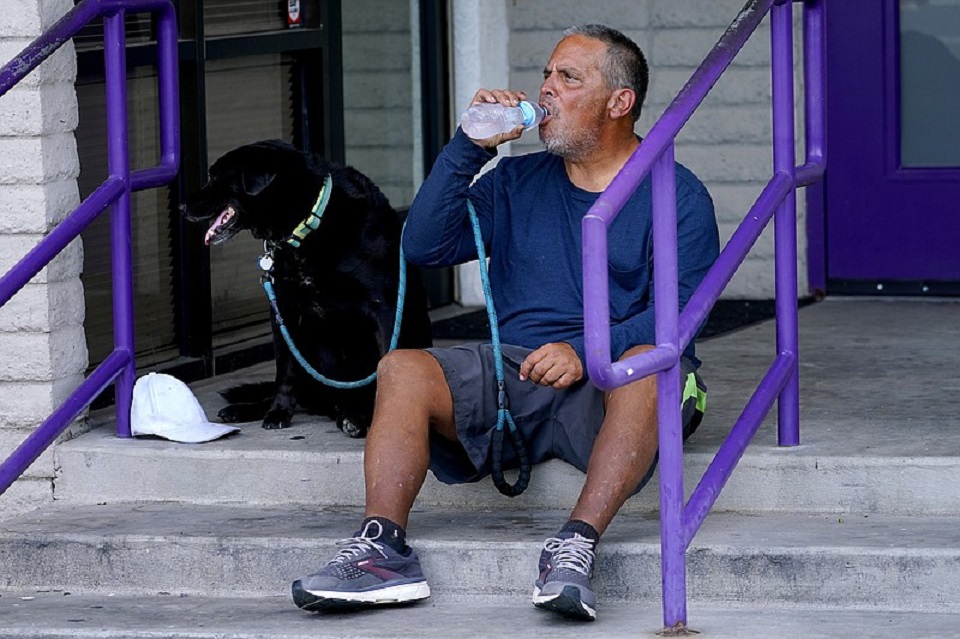
More than 113 million people in the United States are suffering under extreme heat as another massive “heat dome” expands from Texas westward toward California. Meteorologists expect the Southwest’s heat wave to intensify over the weekend, delivering some of the year’s highest temperatures and pushing California’s Death Valley near its all-time-record temperature of over 130 degrees Fahrenheit. The midday heat in cities like Phoenix, Arizona, has become so intense that ordinary surfaces such as streets and metal railings are too dangerous to touch without risking burns.
But apart from these eye-popping highs, experts said the real danger of the Southwest’s heat wave will be its sheer duration. The mass of stagnant air responsible for the event has already lingered over Texas and Louisiana for weeks. It’s feeding on itself to generate more heat as it moves west, depleting ground moisture and discouraging cloud formation, which ensures that it won’t disappear for at least another week. During that time, more than a third of the country’s population will be under a heat warning issued by the National Weather Service.
Daytime highs in Phoenix have already topped 110 degrees F every day in the month of July, and the city is expected to stay that hot for at least another week, shattering the previous record of 18 consecutive days above that threshold. Furthermore, large metro areas like Phoenix will remain hot even in the middle of the night as heat soaks into concrete and asphalt. The daily low temperatures in the nation’s fifth-largest city aren’t expected to fall below 90 degrees F for another week or more.
That long stretch of heat will have disastrous impacts for human health, said Juan Declet-Barreto, a social scientist at the nonprofit Union of Concerned Scientists who studies climate vulnerability.
“The magnitude of these events in terms of the temperatures that are being forecast and the length of time is very, very, very worrisome,” he told Grist. “It’s an absolute crisis.”
The worst-affected populations are outdoor workers and people who get around on foot or using public transportation since they can’t shelter from the heat in air-conditioned environments. If a heat wave only persists for one day, some people can cope by staying inside and blasting air conditioning, but weeks of unrelenting heat make it difficult to avoid the exposure that can cause life-threatening heat stroke.
And that’s not the only worry. A long stretch of triple-digit days can make it harder for the heart to pump blood and the lungs to circulate air, leading to flare-ups of cardiovascular disease and lung disease. Even for people who spend most of their time indoors with the air conditioning on, prolonged heat can lead to dehydration, irritability, confusion, and dizziness. For vulnerable populations like elderly people and those with obesity, health effects can recur for years.
“The body loses the capacity to self-regulate,” Declet-Barreto said of temperatures above 105 degrees F. “This is even truer for populations of advanced age, people with physical or mental disabilities who may not be able to communicate their level of discomfort, and people with fewer resources [who] are going to be hard pressed to run the AC.”
Big cities are even more vulnerable to long heat waves than rural areas because of what’s called the “urban heat island” effect. During a hot day, the pavements and buildings in a city like Phoenix absorb all the heat of the sun as it pours down on city streets. At night, after the sun sets, they release all that trapped heat into the surrounding air, which keeps local temperatures elevated even when there’s no humidity. Furthermore, people who can’t afford to run their air conditioning all day may shut it off at night, leaving them exposed for hours.
“In the southwestern cities like Phoenix that are naturally hot and also have a very brutal urban heat island effect, you’re not going to see any respite,” said Declet-Barreto. “The body doesn’t really get a chance to rest.”
A study published last year in the medical journal The Lancet found that a rise in nighttime temperatures is associated with a rise in heat-related mortality. Most of the deaths are among elderly people, who can face serious health risks even at 90-degree temperatures. Scientists now believe that human-caused climate change has an undeniable effect on almost all contemporary heat waves, making them both more severe and more frequent. As soils dry out and ambient air gets hotter every year, heat waves like the one blistering the Southwest this week are becoming tens or even hundreds of times more likely.
This article was reposted from Grist.org.
We hope you appreciated this article. At People’s World, we believe news and information should be free and accessible to all, but we need your help. Our journalism is free of corporate influence and paywalls because we are totally reader-supported. Only you, our readers and supporters, make this possible. If you enjoy reading People’s World and the stories we bring you, please support our work by donating or becoming a monthly sustainer today. Thank you!










